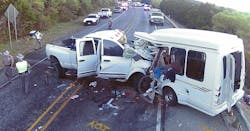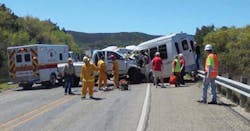Calls for better drug testing, lap-and-shoulder belts as Canada legalizes weed
It was a medley of drugs including marijuana and misused prescription sedatives that led a young Texas driver in a pickup to veer across a highway double-line divide and plow into a van upfit for passenger transport, the National Transportation Safety Board (NTSB) has concluded. NTSB used its investigation to warn of a rise in drugged driving and call for better seatbelts in buses.
The March 2017 crash fatally injured 13 of 14 occupants of the van, and that's partly because many of them didn't have lap/ shoulder seatbelts, NTSB found. The van's driver and front seat passenger did have those as well as airbag protection, but it wasn't enough to save them from the incursion of the truck's heavy impact.
NTSB noted in a release on its investigation that illicit, prescription, and over-the-counter drug use by drivers are on the rise and called for more tools and police training to detect drugged driving "before they crash, regardless of the impairing drug they're using."
According to NTSB's investigation and report, the wreck happened on a Wednesday with clear skies around noon on a two-lane portion of Highway 83 near Concan, TX, about 80 miles west of San Antonio. A 20-year-old driver heading north in a 2007 Ram 3500 pickup had been seen and filmed on the road operating erratically for some 15 minutes by a vehicle behind.
In the video, the pickup swerved into the oncoming lane 19 times—once completely—and over the white shoulder line of its lane 37 times, with "at least five" of those being off into the grass at the roadside. The vehicle behind called police, who then were on their way.
But they didn't get there before the pickup careened head-on into a 2004 Ford E-350 chassis van with a bus body heading south. It's a fairly straight stretch of road there, mostly open for passing and one lane in either direction, but the crash happened after a curve where the pickup drifted again into the oncoming traffic lane. Its driver had remained near the posted 70 mph limit, and the E-350 presumably was at similar speed, though NTSB didn't specify.
The agency's investigation found no fault or error on the part of the 67-year-old van driver. Even just lap belts aren't required by federal law in the upfit bus' rear seats, but this one had them and all passengers were wearing theirs; it caused more extensive injuries than if they'd had lap/ shoulder belts.
That was NTSB's determination. The agency called for an update to federal requirements in that regard and urged bus and bus seat makers to include lap/ shoulder belts as standard, rather than optional.
Drugs and driving
Drugged driving was clearly the primary culprit here, although the pickup driver also told police and NTSB that he'd been texting before the crash occurred. "It is possible that the truck driver was glancing at or manipulating his cell phone at the time of the crash, but this action would not explain the prolonged and continuous erratic driving behavior," NTSB's report abstract reads.
The pickup driver had smoked and unsmoked joints (marijuana cigarettes) in the cab and said he'd taken double his prescribed dose of clonazepam, a sedative used to treat seizures, panic disorder, and anxiety. Police also found over-the-counter drugs in the truck.
NTSB noted that in recent years, more drivers have been using drugs of various kinds and getting behind the wheel. The agency called for more police training to detect drug use and better test methods that can be used, for example, at road checkpoints.
NTSB's report comes just as Canada nationally legalizes recreational marijuana use today. Roadside testing isn't so simple in the case of pot, since it can be traceable in users for some 3-4 weeks in the blood and it's more difficult to determine impairment vs. simple presence of the drug.
That's going to be key now as access to and legally-okayed use of weed is much broader, with Colorado, Washington, Oregon, California, Nevada, Massachusetts, Maine, Vermont, Alaska, and even the nation's capital, the District of Columbia, permitting recreational use by adults over 21—very similar to alcohol use guidelines—and Canada now having done so collectively.
One company up north, Alco Prevention Canada, yesterday announced its new oral fluid cannabis (marijuana) test, Cannabis Verdict. The test "immediately" can detect recent cannabis use within about the last 6-8 hours when the person's saliva has a threshold concentration of 20 ng/ ml or greater of tetrahydrocannabinol, or THC, marijuana's main active ingredient.
The test is meant for preventive and educational use, according to the company, and doesn't determine impairment—so in any potential consideration or use by law enforcement, would need to be supplemented when possible with field testing and observation. Still, Alco Prevention calls it "the simplest and fastest" marijuana test available in Canada.
"Impairment will vary depending on an individual's physiology and cannabis usage. Residual THC levels may remain in an individual's system for days and/or weeks," Fleet Owner was told by a representative of the device maker. "Typically, [THC] levels will drop below 20 ng/ mL after 6-8 hours in both occasional and chronic users. Chronic users will have higher residual levels over a longer period of time than occasional users, but most often these are below the 20 ng/ mL level."
Mixed messaging on pot
A complicated situation has been brewing for many years concerning marijuana and America's roadways. It's not like alcohol, where extensive testing has been done and levels set concerning vehicle operation impairment and blood alcohol content levels, and the drug is metabolized quickly out of the body.
Indeed, drinkable alcohol—C2H5OH—is very often referred to, even among public and medical officials, as "alcohol or drugs" as though it's not a drug.
But the U.S. government's longtime categorization of marijuana as a Schedule 1 drug has restricted use and testing of cannabis. Along with heroin and LSD, Schedule 1 drugs are classified as those that have no medical purpose or safe use under medical supervision.
At the same time, 30 U.S. states allow marijuana to be prescribed to help suppress nausea/ discomfort and encourage eating for those dying of cancer, among other patients. And in the growing legalization of recreational use, marijuana is often referred to as more benign and less harmful than permanently physically-addictive alcohol or even nicotine.
Thus pot is both demonized and stigmatized—e.g., the "devil's lettuce"—on the one hand, while treated as safe for adult use or even beneficial on the other, including by a neighboring nation, creating a wildly polarized image and uneven public perception. The situation becomes even more complicated when it comes to commercial vehicle operation.
Notably, the 20-year-old pickup truck driver in NTSB's crash investigation would not have had legal access to marijuana in U.S. states that have green-lighted recreational use. Also of note, NTSB highlighted better drug testing methods/ devices and education for law enforcement, but didn't mention public awareness and education campaigns.
The National Highway Traffic Safety Administration (NHTSA) did, however, as that agency recently discussed its latest data on roadway fatalities. NHTSA explained that fatalities from motor vehicle crashes have decreased in many cases, except those involving large trucks and urban areas, and also pointed to an increase in drugged driving.
"It's a very complicated issue, it's emerging very rapidly, and we're working very hard to develop the tools to support highway safety," said Heidi King, deputy administrator of NHTSA. The agency has launched a campaign to tell drivers, "If you feel different, you drive different" and "Drive high, get a DUI."
Law enforcement officers largely credit years of similar—and concerted—public education efforts and ramped-up penalties for reducing drunk driving significantly today from the once nonchalant acceptance and prevalence it had in decades past.
About the Author
Aaron Marsh
Aaron Marsh is a former senior editor of FleetOwner, who wrote for the publication from 2015 to 2019.


